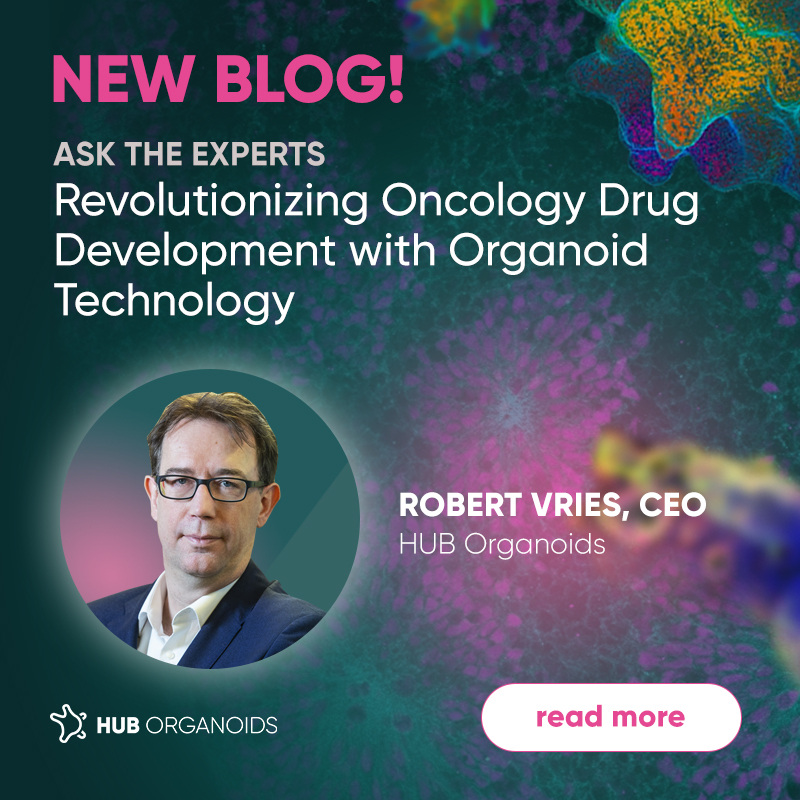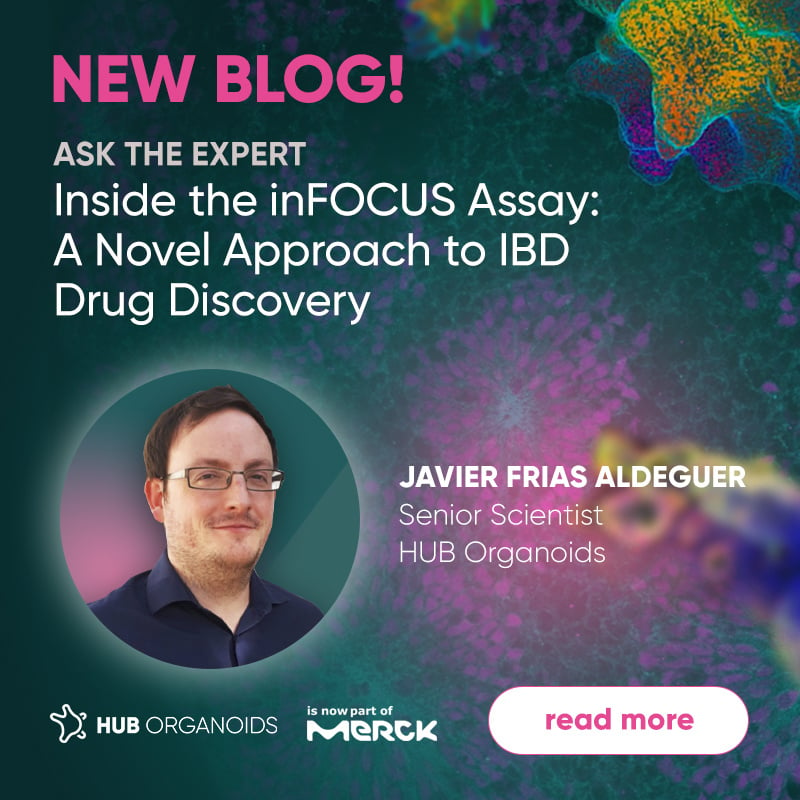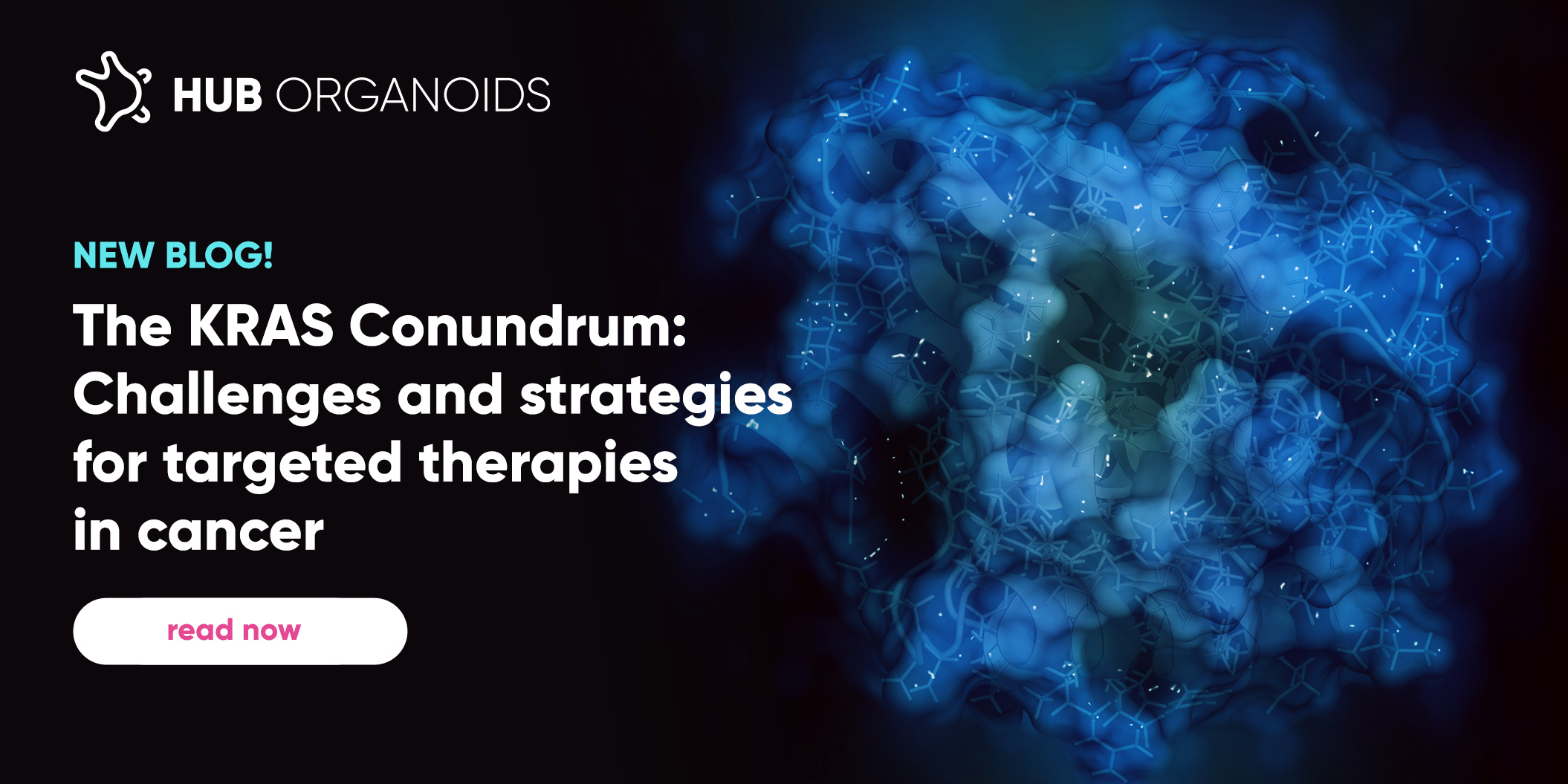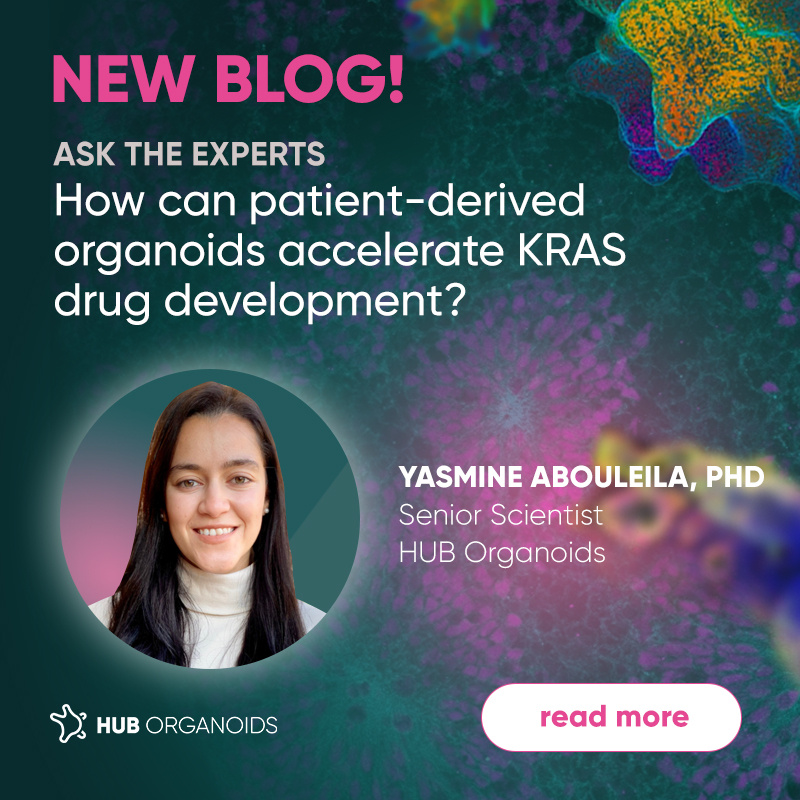Ask the experts: Revolutionizing Oncology Drug Development with Organoid Technology
Published by HUB Organoids on May 7, 2024

This "Ask the Experts" feature delves into the pressing inquiries regarding the application of patient-derived organoid technology in cancer research. Dr. Robert Vries, our CEO, extensively discusses the implications of the FDA Modernization Act 2.0, the integration of organoids in the development of oncology drugs, and our notable scientific advancements in refining our service offerings for oncology and immuno-oncology drug development.

What are some of the challenges for drug discovery and development when targeting cancer?
Robert Vries:When it comes to targeting cancer in drug discovery and development, there are several major challenges to overcome but the biggest challenge is patient heterogeneity. Many innovative and potentially very effective drugs have been developed but fail to have a clinical impact on a significant part of the patient population. Patient heterogeneity is the result of inherent (epi) genetic differences between patients. In addition, tumor heterogeneity poses a significant obstacle, as cancers exhibit diverse genetic and phenotypic characteristics and finally, drug resistance frequently emerges. Identifying predictive biomarkers for patient response remains elusive, and traditional preclinical models do not adequately mimic patient heterogeneity. High costs and time associated with drug development resulting from these challenges further exacerbate these challenges. Addressing these hurdles demands innovative approaches, collaborative efforts, and interdisciplinary research to advance cancer therapeutics effectively.
Why are oncology drug attrition rates so high?
Robert Vries: New oncology drug attrition rates, hovering around a staggering 95%, embody the major hurdles in the fight against cancer. While we have rich preclinical pipelines, translating promising preclinical candidates into successful therapies for patients remains a daunting task. This is attributable to multiple factors. First and foremost, we understand that cancer is not a single disease, but a diverse collection of malignancies with unique mutations and driver genes in multiple signaling pathways. Targeting these intricate mechanisms effectively is challenging, often leading to drugs that work well in preclinical models but fail in clinical trials due to the complexity and diversity of human tumors.
The inefficient translation starts as early as target discovery often based on large-scale genome analysis to identify what enables cancer cells to grow and survive. The rationale for new precision drugs is then developed based on the observed genetic mutations. With over 20,000 potential anti-cancer targets in the genome, determining which are suitable to target for specific types of cancers and patients is a significant challenge. Improved target discovery strategies need to reconcile advanced genomics with functional readouts to understand at an early stage if genetic changes can be effectively targeted in the complexity of all cellular interactions.
Even drugs with promising targets from early-stage investigation can have unintended off-target effects. Their interactions with healthy cells in the affected organ or elsewhere in the body can lead to severe side effects, forcing drug developers to abandon otherwise promising candidates due to safety concerns. We need to be able to design drugs with more specific mechanisms of action based on pathology-relevant and patient-specific targets.
Once a new anticancer agent has successfully reached late-stage preclinical development, identifying reliable biomarkers that accurately predict patient response is a challenge. This makes it difficult to select the right patient population for clinical trials and assess the true efficacy of new therapies. Personalized medicine approaches to match the right drugs to the right patients based on their specific functional cancer characteristics will greatly improve treatment strategy by identifying drugs that effectively target a subset of patients.
Many of the challenges above are the result of using suboptimal models for drug development research. Animal models and cell lines, while valuable, don't recapitulate human cancer biology and even more, cannot capture patent heterogeneity. This generates misleading results, where drugs appear effective during development but have limited impact on patients. Adopting more sophisticated preclinical models that better mimic human cancer early in drug development can have a significant impact and can potentially offer a solution to all the above challenges.
What benefits does 3D biology such as organoids have over traditional 2D methods like cell cultures?
Robert Vries: In my view, the question is no longer whether 3D models better recapitulate the original tissue pathophysiology compared to 2D models. There is a wealth of research demonstrating that growing cells in 2D affects signaling pathways and gene expression and that cancer cell lines have adapted to grow on plastic so much so that they resemble each other more than they resemble their original tumors. Performing drug screening on cancer cell lines has unquestionably led to poor selection of drug candidates and has prompted the US NCI to retire their NCI60 panel back in 2016 in favor of more patient-relevant models.
2D cell lines are robust, highly scalable, and reproducible. 3D spheroid models had to trade off some of that scalability and robustness in favor of physiological relevance but in most cases failed to meet the expectation of providing a more patient-relevant option. This is because they are still derived from the same 2D cell lines which are now allowed to grow in 3D.
Organoids have changed the paradigm in drug development, and this is not just because they are grown in 3D. They are derived from adult stem cells which when cultured in the right conditions are capable of duplicating and differentiating much like they would do if they were still inside their organ of origin. With organoids we are no longer attempting to recapitulate a 3D architecture, we are letting biology do what it would in its native state. We are developing “mini organs in a dish” that preserve the genetic make-up and physiological function of the original patient tissue. Because we are not manipulating patient tissue to allow it to grow outside of the body, we can develop organoids from healthy tissue as well as from diseased tissue and this opens immense opportunities for cancer research as well as for any other genetic disorder where relevant preclinical models are currently lacking.
How welcome is the FDA Modernisation Act 2.0 and how it will help inform drug discovery approaches in oncology?
Robert Vries: You know, I have been monitoring these developments closely. Most regulatory bodies agree on the need for replacing, reducing, and refining the use of animal models. Once again, the field is trying to move on from traditional cell lines as they recognize their poor translatability to patients, in favor of more patient-relevant alternatives. For cancer research, this meant using xenografts or syngeneic models. PDXs became mainstream models as they seemed to offer a promising approach to precision medicine. However, these models are very resource intensive. They take months to establish and fail for many tumors, are expensive to maintain in live passage, and are hardly scalable for preclinical studies. Unfortunately, the use of these models has not significantly improved oncology drug development which still suffers from high attrition. Organoids can move the needle. They are robust, easily scalable, reproducible, and cost-effective patient-derived models and most importantly they have been shown by multiple independent studies to be able to predict patient response in the clinic. Therefore, organoids can be used to identify promising compounds in early discovery to clinical application. At HUB we have used organoids as a personalized medicine platform for cystic fibrosis patients with ultra-rare mutations who did not qualify for clinical trial enrollment. For these patients who did not respond to the standard of care, treatment selection was done in the lab, on their organoids, which were developed and tested to identify a successful treatment regimen in a matter of weeks. This would not have been possible with any other existing preclinical model.
Our data show that this approach is equally feasible for cancer patients as patient-derived tumor organoids mirror the corresponding patient response to treatment. Our clients who have implemented organoids in their pipeline can fast-track the selection for a clinical candidate because they no longer need to perform large-scale cell line screens for hit finding and have significantly reduced the need for in vivo validation data.
Do you see immunotherapies as the future on cancer care?
Robert Vries: Immuno-oncology is an interesting area of clinical research and holds great promise for long-term remission. However, we need to gain a better understanding of the interaction between the immune system and the tumor before we can make significant strides. After the promising start of immune therapies it is now evident that also with immune therapy many of the known challenges of drug development have remained and in the future, it will likely be one of the treatment strategies for cancer along with other drug treatment modalities.
Additionally, the identification of biomarkers is even more complex as it will need to assess both the immune system and the tumor. So far this remains a challenge, leading to suboptimal treatment outcomes and unnecessary side effects for non-responders.
Currently, available preclinical models are far from offering robust solutions as recapitulating a fully developed human immune system in an animal model is not a small challenge. Organoids can be co-cultured with autologous or non-autologous immune cells to evaluate response to treatment and since they preserve patient-specific tumor antigens, can represent an interesting model to pursue.
Following that, how important is the use of organoids for precision medicine approaches within oncology?
Robert Vries: It is game-changing for all the reasons already mentioned. In cancer treatment what it boils down to is if a drug kills the patient tumor cells. Organoids represent the only model that allows a functional experiment to test this. All of our genetic and mechanistic understanding of the biology of cancer is very important for drug development, but in the end, this simple question needs to be answered, preferably before entering clinical trials.
Organoids allow this effectively and practically because of their speed of development, genomic stability, disease relevance, and predictive power. Organoids are moving the needle from a gene-centric to a patient-centric approach to drug development.
What’s the adoption rate like for organoids within drug discovery currently?
Robert Vries: It is an actively growing space. We invested significant efforts in standardizing culture conditions and adopting automation to scale up and meet industry standards. Most large pharmaceutical companies have in-licensed our technology and use our services for their screening program or new model & assay development. Others prefer to outsource recurrent synthetic lethality screens on large libraries of compounds to prioritize targets. Smaller biotechs tend to adopt organoids for translational studies but with increasing awareness around their benefits, they are starting to use organoid technology at early stages as well. Recently we have been able to support several pharma partners with the development of new models specific to their drug program at the discovery stage and supported the development to clinal trial introduction. The industry is increasingly recognizing value and benefitting from accelerated development programs and increased clinical success.
For cancer research, why are more patient-relevant models needed in pre-clinical discovery?
Robert Vries: Because the current drug development paradigm is expensive, inefficient, and costly. We all recognize the need for change. At HUB we believe in putting patients and not drugs or drug targets at the center of drug development. New therapeutics should be developed using preclinical models that faithfully recapitulate a patient´s disease in the lab, can provide answers within the lifetime of a patient, and can be trusted to predict patient response in the clinic.
Could you discuss HUB Organoid’s biobanking approach for bladder cancer and how ambitions such as that can help close the translational gap?
Robert Vries: The program represents the key paradigm of using organoids. Starting by generating an organoid biobank of the target patient population. Our bladder cancer biobank is one of our best characterized collections of matched bladder cancer and normal bladder organoids. The confidence that the discovery phase is carried out on a model that was shown to faithfully mimic patient response makes the subsequent drug development program efficient as well as time and cost-effective. The development of this biobank represented a cornerstone for our clients in this space as they were able to select the next generation of cancer drugs with confidence by screening a large collection of models. But bladder is not an isolated case. Colorectal cancer organoids are another excellent example. The signaling pathways that regulate normal human intestine regeneration and colon cancer tumorigenesis are incredibly similar. Thanks to this understanding we were able to help our client develop a compound that stops cancer stem cell proliferation, thus inhibiting tumor growth. In another case, we employed our colon, ovarian, head and neck, breast, lung, and pancreatic organoids in a "basket screen" setup to evaluate the efficacy and safety of an engineered T-cell. This process assisted our client in determining the primary solid tumor indication to prioritize for clinical trials.
In terms of cost, do organoids provide a cost-benefit or expedited timelines to teams?
Robert Vries: As mentioned, organoids provide both, accelerated preclinical timelines by avoiding the need for testing in multiple preclinical models and better candidate compounds because they effectively predict patient response. This translates into more efficient preclinical development and cost savings from deprioritizing suboptimal candidates at an early stage and progressing only compounds with a high chance of success in the clinic. Using organoids from an early stage of drug discovery to clinical application makes it an incredibly valuable tool because of its cost-effectiveness.



